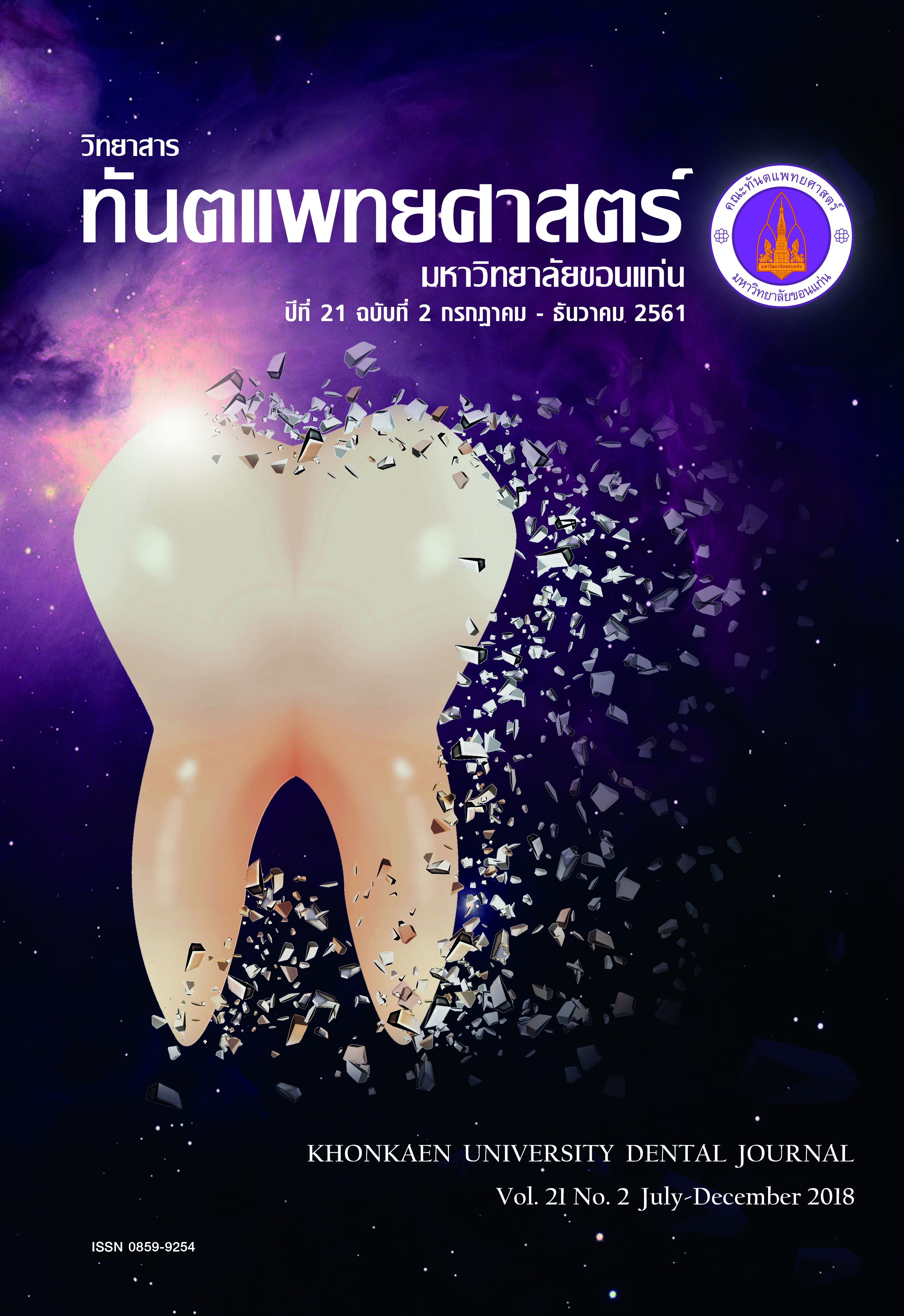Biocompatibility of Glass Ionomer Cement Containing Monocalcium Silicate Compound on Human Osteoblast
Main Article Content
Abstract
Monocalcium silicate is one of calcium silicate based materials that have bioactive properties and influence cellular biologic response. Many studies attempted to improve biological property of glass ionomer cement by adding Monocalcium silicate. The purpose of this in vitro study was to evaluate biocompatibility, biomineralization capacity, and cell morphology of human alveolar osteoblast on glass ionomer cement containing monocalcium silicate cement or GI-CS. Method: Human osteoblast derived from human alveolar bone were used. The biocompatibility of glass ionomer cement containing 50% w/w monocalcium silicate was examine the cell viability and proliferation by MTT assay. The optical density was measured by a spectrophotometer at 570 nm. The cell morphology was investigated by Scanning electron microscope. Biomineralization assay was tested by Alizarin red staining. Result: GI-CS increased cell proliferation significantly at 1, 3 and 7 days (P<0.05). In day 3 and day 7, Cell viability of GI-CS was significantly higher than that of MTA (P < 0.05). The scanning electron microscope revealed cell spreading on both GI-CS and MTA. And both materials had biomineralization capacity. Conclusions: GI-CS and MTA showed good biocompatibility on human osteoblast.
Article Details
บทความ ข้อมูล เนื้อหา รูปภาพ ฯลฯ ที่ได้รับการลงตีพิมพ์ในวิทยาสารทันตแพทยศาสตร์ มหาวิทยาลัยขอนแก่นถือเป็นลิขสิทธิ์เฉพาะของคณะทันตแพทยศาสตร์ มหาวิทยาลัยขอนแก่น หากบุคคลหรือหน่วยงานใดต้องการนำทั้งหมดหรือส่วนหนึ่งส่วนใดไปเผยแพร่ต่อหรือเพื่อกระทำการใด ๆ จะต้องได้รับอนุญาตเป็นลายลักษณ์อักษร จากคณะทันตแพทยศาสตร์ มหาวิทยาลัยขอนแก่นก่อนเท่านั้น
References
2. Bodrumlu E. Biocompatibility of retrograde root filling materials: A review. Aust Endod J 2008;34(1):30-5.
3. Torabinejad M, Ford TRP. Root end filling materials: a review. Dent Traumatol 1996;12(4):161-78.
4. Hench LL. Bioceramics. J Am Ceram Soc 1998;81(7): 1705-28.
5. Torabinejad M, Rastegar AF, Kettering JD, Pitt Ford TR. Bacterial leakage of mineral trioxide aggregate as a root-end filling material. J Endod 1995;21(3):109-12.
6. Torabinejad M, Pitt Ford TR, McKendry DJ, Abedi HR, Miller DA, Kariyawasam SP. Histologic assessment of mineral trioxide aggregate as a root-end filling in monkeys. J Endod 1997;23(4):225-8.
7. Economides N, Pantelidou O, Kokkas A, Tziafas D. Short-term periradicular tissue response to mineral trioxide aggregate (MTA) as root-end filling material. Int Endod J 2003; 36(1):44-8.
8. Ber BS, Hatton JF, Stewart GP. Chemical modification of proroot mta to improve handling characteristics and decrease setting time. J Endod 2007;33(10):1231-4.
9. Islam I, Kheng Chng H, Jin Yap AU. Comparison of the physical and mechanical properties of MTA and Portland cement. J Endod 2006;32(3):193-7.
10. Cao W, Hench LL. Bioactive materials. Ceram Int 1996; 22(6):493-507.
11. Heness G, Ben-Nissan B. Innovative bioceramics [monograph on the internet] Australia: Institute of Materials Engineering; 2004 [cited 2018 Feb 1]. Available from: https://hdl.handle. net/10453/5698.
12. Siriphannon P, Kameshima Y, Yasumori A, Okada K, Hayashi S. Comparitive study of the formation of hydroxyapatite in simulated body fluid under static and flowing systems. J Biomed Mater Res 2002;60(1):175-85.
13. Ni S, Chang J, Chou L, Zhai W. Comparison of osteoblast-like cell responses to calcium silicate and tricalcium phosphate ceramics in vitro. J Biomed Mater Res 2007;80(1):174-83.
14. Ni S, Chang J. In vitro Degradation, Bioactivity, and cytocompatibility of calcium silicate, dimagnesium silicate, and tricalcium phosphate bioceramics. J Biomater Appl 2008;24(2):139-58.
15. Wei J, Chen F, Shin J-W, Hong H, Dai C, Su J, et al. Preparation and characterization of bioactive mesoporous wollastonite–polycaprolactone composite scaffold. Biomaterials 2009;30(6):1080-8.
16. Shirazi F, Moghaddam E, Mehrali M, Oshkour A, Metselaar H, Kadri N et al. In vitro characterization and mechanical properties of β-calcium silicate/POC composite as a bone fixation device. J Biomed Mater Res 2014;102(11):3973-85.
17. Pothiraksanont S. A Comparative study of physical properties of GIC containing β-monocalcium silicate to mineral trioxide aggregate [dissertation]. Srinakarinwirot University; 2013.
18. Chaisinghanuae P. Cytotoxicity and osteogenic properties of glass ionomer cement containing monocalcium silicate compound in human dental pulp cells [dissertation]. Srinakarinwirot University; 2014.
19. Sangsawatpong W. Bioactivity and biocompatibility of glass ionomer cement added with monocalcium silicate at various ratios [dissertation]. Srinakarinwirot University; 2013.
20. Horvichitr P. Sealing ability and bacterial leakage of glass ionomer cement containing monocalcium silicate [dissertation]. Srinakarinwirot University; 2014.
21. Burapat B. Sealing ability and marginal adaptation of glass ionomer cement containing β-monocalcium silicate. SWU DENT J 2016;9(2):26-38.
22. International Organization for Standardization. Sample preparation and reference materials. Biological evaluation of medical devices. 4th ed. ISO: Switzerland; 2012. 4-10.
23. Keiser K, Johnson CC, Tipton DA. Cytotoxicity of mineral trioxide aggregate using human periodontal ligament fibroblasts. J Endod 2000;26(5):288-91.
24. Mosmann T. Rapid colorimetric assay for cellular growth and survival: Application to proliferation and cytotoxicity assays. J Immunol Methods 1983;65(1):55-63.
25. Hatton PV, Hurrell-Gillingham K, Brook IM. Biocompatibility of glass-ionomer bone cements. J dent 2006;34(8): 598-601.
26. Valerio P, Pereira MM, Goes AM, Leite MF. The effect of ionic products from bioactive glass dissolution on osteoblast proliferation and collagen production. Biomaterials 2004;25(15):2941-8.
27. Lee B N, Son H J, Noh H J, Koh J T, Chang H S, Hwang I N, et al. Cytotoxicity of newly developed ortho MTA root-end filling materials. J Endod 2012;38(12):1627-30.
28. Ahmed HM, Luddin N, Kannan TP, Mokhtar KI, Ahmad A. Cell attachment properties of portland cement-based endodontic materials: Biological and methodological Considerations. J Endod 2014;40(10):1517-23.
29. Anselme K. Osteoblast adhesion on biomaterials. Biomaterials 2000;21(7):667-81.
30. Jung G Y, Park Y J, Han J S. Effects of HA released calcium ion on osteoblast differentiation. J Mater Sci 2010;21(5):1649-54.
31. An S, Gao Y, Ling J, Wei X, Xiao Y. Calcium ions promote osteogenic differentiation and mineralization of human dental pulp cells: implications for pulp capping materials. J Mater Sci 2012;23(3):789-95.
32. Maeno S, Niki Y, Matsumoto H, Morioka H, Yatabe T, Funayama A, et al. The effect of calcium ion concentration on osteoblast viability, proliferation and differentiation in monolayer and 3D culture. Biomaterials 2005;26(23): 4847-55.


